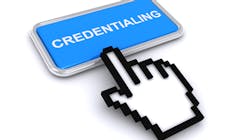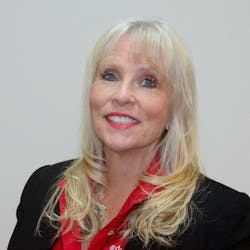Credentialing trends dentists should watch in light of COVID-19
As many dental practices are forced to curtail patient visits to slow the spread of COVID-19, providers are more reliant than ever on their payer networks to maintain positive and timely cash flow. The situation highlights the need for web-based credentialing services that are accurate and efficient. We interviewed LeAnn Morris, vice president of business development for DentalXChange to learn more. Her company is a creator of electronic solutions for the dental industry, including the DDS Enroll web-based credentialing software platform. We discuss current credentialing trends, the pandemic’s impact on dentistry, and credentialing innovations dentists should watch out for in the near future.
Interview with LeAnn Morris, VP of business development, DentalXChange
DentistryIQ: During this period of disruption, many dentists and dental practices are reevaluating their vendors, systems, and value propositions. From a high-level view, what industry-wide credentialing trends are underway in dentistry? What is driving these trends, and why should dentists be paying attention?
DIQ: How has your company positioned itself to meet these trends?
As it relates to credentialing, our company has developed DDS Enroll, a web-based credentialing service that can be co-branded for any payer network and is customizable to payer specifications and workflows. DDS Enroll solves problems in a measurable way for both payers and providers. Payer networks that have co-branded with DentalXChange on DDS Enroll have seen results that improve their efficiency and ability to serve providers.
For example, we have testimonial from Delta of Missouri that by supporting DDS Enroll, the reduction in their labor efforts and manual process allowed them to continue to support the volume with reduced staffing. This is especially critical as dentists struggle with less predictable cash flows as a result of COVID-19.
DIQ: Historically, all major economic events in the US have impacted dentistry permanently. For example, the Great Recession of 2008 forced practices to look at their fundamental services and expand their offerings. Looking to the future, what impact do you think the COVID-19 pandemic will have on dentistry, and more specifically, dental credentialing in the short and long term?
Morris: The COVID-19 pandemic has without question highlighted the importance of technology use for all businesses. Strong internet connectivity, digital devices, software, and platforms that can be accessed away from the office have enabled countless businesses to continue operating in a remote format.
The dentistry industry, while slow to adopt advanced technologies, now sees how vital these systems are to the efficient operation and management of dental practices. For example, our claims solution, ClaimConnect, allows remote staffing to continue to have access to real-time eligibility and other services that are desperately needed while supporting emergency services from outside the office. DDS Enroll helps streamline credentialing in a revolutionary way that will continue to evolve as we store the provider data to limit repetitive inputting of information.
With platforms like these emerging and becoming so necessary during the COVID-19 crisis, dentists are being pulled into the future more rapidly and will naturally become more open to and reliant on technology to run their practices. These systems and services will only expand and become more prevalent as demand from providers increases. What was acceptable in the past, such as sending claims paper to payers, is no longer the case with mailrooms and basis operations limited or shut down, pushing more providers to move to current efficient processes such as electronic data interchange (EDI).
DIQ: What do you feel are the main pain points dental practices face today when it comes to credentialing? How has your team identified these, and what solutions have you created to address them?
Morris: We listened to group dental practices and payers throughout the country over many years to learn about their credentialing pain points. This feedback helped us build for dentists and dental payers a product from the ground up that would solve these issues for payers and providers universally. Our competitive advantage is that we are not molding a medical product to fit the dental industry.
Credentialing has traditionally been accomplished through a paper filing process that can take up to 90 days to complete. During that period, providers were unable to check on their credentialing status and were required to submit duplicate lengthy applications across all carriers. The long time frame meant that many providers’ credentials expired before they could be renewed—an expensive problem to fix.
We attempted to solvesall of these pain points in DDS Enroll. By allowing credentialing and recredentialing application packets to be submitted electronically, the software provides the payers the tools to deliver such results as reducing credentialing processing times from 90 days to as little as 10 days—an 89% decrease in wait time. This is accomplished due to the quality of the applications delivered to the payers, which allow then to process credentialing approvals instead of performing follow up on incomplete applications and chasing documentation to support the credentialing request.
The program also allows providers to log in and monitor their credentialing process in real time; provides an all-payer solution instead of a single-payer solution, which eliminates the need to duplicate data entry for very lengthy applications; and delivers recredentialing notifications within DDS Enroll and ClaimConnect with access to nearly every provider desktop, reducing credentialing expirations due to missing notifications and freeing up in-house staff as well as eliminating the need to outsource this process.
Payers who co-brand with DDS Enroll are finding that they can go live within 60 days and are supported with a dedicated account manager, weekly calls, and an in-house, all USA-based credentialing-specific support center. Simply put, the software makes credentialing and other previously burdensome processes as expedient and pain-free as possible for both payers and providers. And, ClaimConnect is a widely recognized dental portal in the industry, supporting the top national carriers.
DIQ: DentalXChange recently expanded its DDS Enroll credentialing software platform. What was the impetus for this expansion? What was the fundamental problem you were trying to solve?
Morris: DentalXChange recently completed two new contracts with Delta Dental payer networks, expanding DDS Enroll to six states. These networks included Delta Dental of Arizona and Delta Dental of New Jersey and Connecticut, who joined our existing DDS Enroll users Delta Dental of Colorado, Delta Dental of Missouri, and Delta Dental of South Carolina, with four additional plans scheduled for implementation in 2020.
These new partnerships allow DDS Enroll to be utilized by virtually every dental provider in Arizona, New Jersey, Connecticut, Colorado, Missouri, and South Carolina.
In less than two years since its launch, a wide variety of payer networks have shown interest in this software as they learned how it delivers efficiency and solutions to their challenges. Our goal is to make these valuable services available to a wider group of dental professionals, and we look forward to partnering with additional networks throughout the country as interest in the product continues to expand.
DIQ: Apart from what you've already touched on, are there any credentialing innovations that dentists should be looking for in the coming years? And what's the most important takeaway dentists should leave with when it comes to credentialing?
Morris: The credentialing timeline will continue to shorten as updates are made to the existing software platforms.
As the dental industry increasingly adapts to utilizing these online platforms, demand will increase for technology that connects payers and providers, allows them to interact more readily, and enables them to operate at higher levels of accuracy and efficiency. The focus for credentialing is to assure electronic delivery of notifications, reduce repetitive data entry of provider information, and assure payers have clean and complete applications. With that being designed and delivered, the approvals will improve and allow dental providers to start or continue to see patients under the given networks.
Zachary Kulsrud is the group editorial director for Endeavor Business Media's dental group, publishers of Dental Economics, DentistryIQ, Perio-Implant Advisory, and RDH magazine.
Recommended
- New ADA HPI research brief projects 66.5% reduction in dental spending for 2020
- 5 ways a loan can help dentists and their practices during the COVID-19 crisis
- Changes dentists should make before they reopen
Editor's note: To view DentistryIQ's full coverage of the COVID-19 pandemic, including original news articles, video interviews, and downloadable forms, visit the DentistryIQ COVID-19 Resource Center.
About the Author

Zachary Kulsrud
Zachary Kulsrud is the editorial director for Endeavor Business Media's dental group, publishers of Dental Economics, DentistryIQ, Perio-Implant Advisory, and RDH magazine.
Updated July 7, 2020

